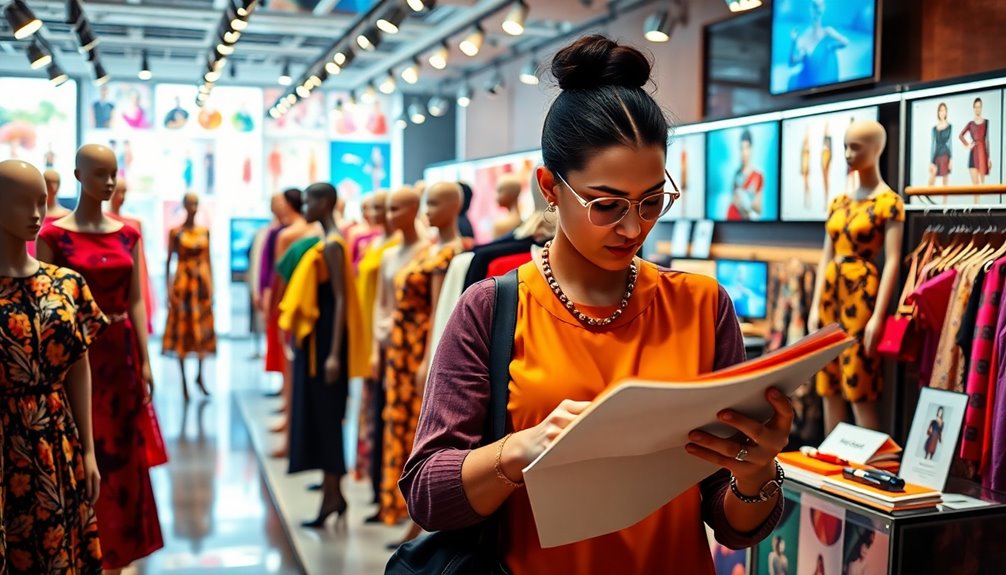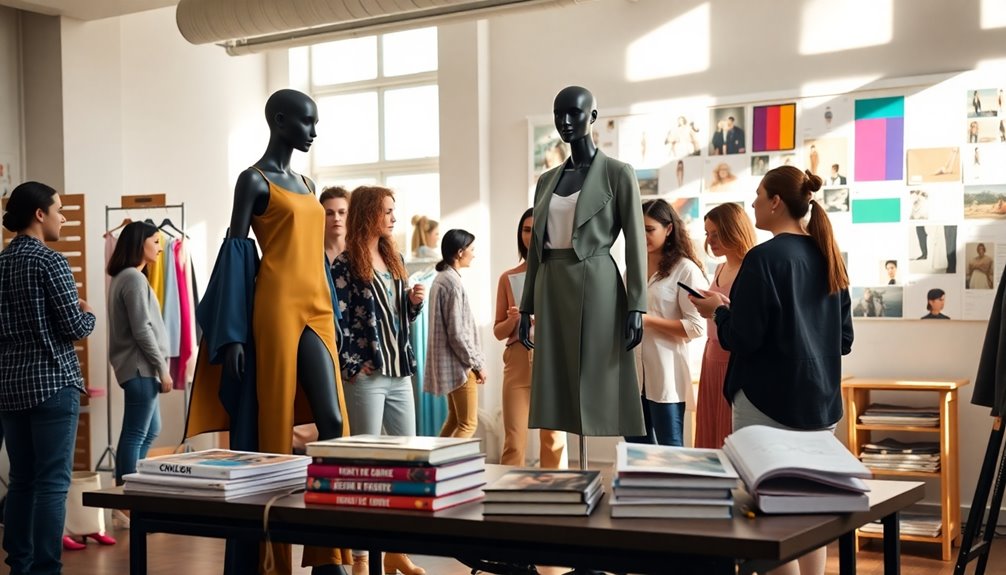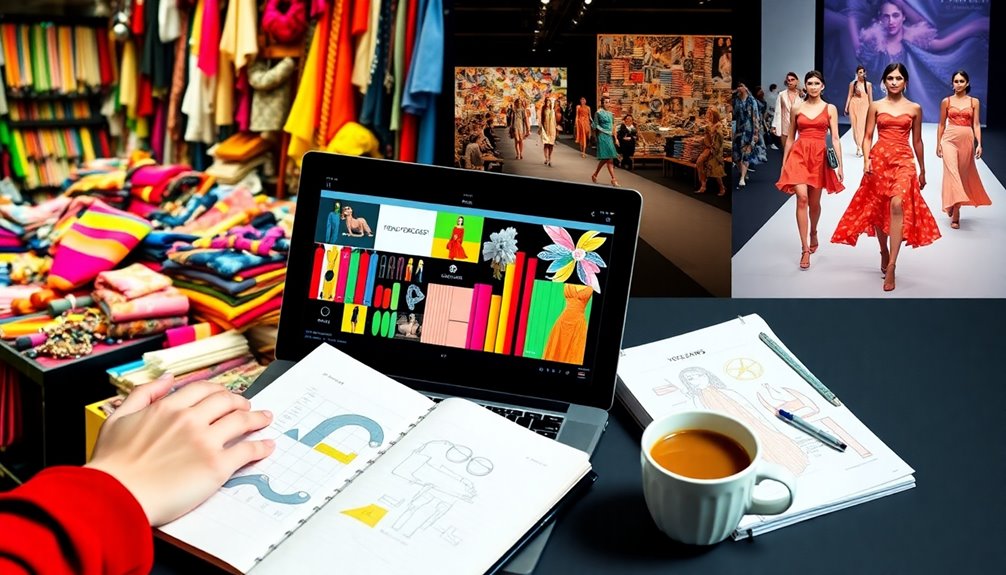As a fashion merchandiser, you blend creativity with strategic thinking to thrive in a dynamic, $368 billion industry. Your journey involves analyzing trends, managing inventory, and collaborating with designers to select the right products. You'll need a strong foundation in fashion and business, often requiring a bachelor's degree and practical experience. Key skills like analytical thinking, creativity, and effective communication are essential. This career offers various paths, from entry-level roles to specialized positions in luxury fashion. Building a solid network is vital for growth and opportunities. Keep exploring, and you'll uncover even more about this exciting field.
Key Takeaways
- Fashion merchandising merges creativity and strategy to attract consumers through trend analysis and product selection.
- A bachelor's degree in fashion merchandising or related fields is typically required, alongside internships for practical experience.
- Essential skills include analytical thinking, creativity, communication, and organizational abilities to navigate the dynamic fashion landscape.
- Career progression can lead from entry-level roles to senior positions, with opportunities for specialization in niches like e-commerce.
- Networking is crucial in the fashion industry, providing mentorship, insights, and potential career advancements through professional relationships.
Overview of Fashion Merchandising

Fashion merchandising is a dynamic field that blends creativity with strategic planning to captivate consumers. As a fashion merchandiser, you'll evaluate trends and analyze buying patterns to make informed product decisions.
You'll collaborate with designers to select items that resonate with your target market while negotiating contracts with suppliers to guarantee the best deals. Your daily tasks will include analyzing sales data to track product performance, coordinating with suppliers, and assisting visual merchandisers to create appealing displays.
You'll also manage inventory levels, making sure you have the right products available at the right time. By staying attuned to market demands, you'll effectively implement merchandising plans that drive sales and enhance brand visibility, making your role essential in the fashion industry.
Educational Requirements

To thrive in the fashion merchandising field, a solid educational foundation is essential. Most employers prefer a bachelor's degree in fashion merchandising, business, or marketing. Your coursework should ideally cover textile theory, retail management, and merchandise planning.
While a bachelor's degree can open many doors, some entry-level positions might only require an associate degree.
Gaining practical experience through internships or entry-level roles is vital. This hands-on experience helps you grasp industry nuances and build valuable skills.
Additionally, pursuing advanced education, like a Master of Professional Studies (MPS), or specialized certifications can greatly enhance your career prospects. By focusing on your education and gaining relevant experience, you'll position yourself for success in this dynamic industry.
Key Skills for Success

In the fast-paced world of fashion merchandising, possessing the right skills can make all the difference in achieving success.
You'll need strong analytical skills to interpret data and forecast trends effectively. Creativity is vital, too, as it helps you develop innovative solutions that resonate with consumers.
Furthermore, effective communication and negotiation skills will empower you to engage stakeholders and foster valuable relationships with suppliers. Organizational abilities are essential for managing schedules and budgets efficiently.
Staying updated on evolving fashion trends is a must, as this knowledge informs your strategic decisions.
Finally, the ability to analyze market research and consumer surveys enables you to make informed choices that drive sales and enhance brand visibility. Additionally, strong communication skills enhance clarity and build rapport, which is crucial for fostering collaboration in the fashion industry.
Embrace these skills to thrive!
Career Progression Paths

Steering the career progression paths in fashion merchandising can be both exciting and rewarding.
You'll likely start in entry-level roles like Allocator or Merchandising Assistant, where you'll gain valuable experience and insights into the industry. As you develop your skills, you could advance to positions like Senior Merchandiser or even Head of Merchandising. Utilizing AI-driven analysis can provide you with a competitive edge in understanding market trends and consumer behavior. Furthermore, the integration of AI in healthcare is showcasing how technology can revolutionize industries, which can inspire innovative approaches in fashion as well. Additionally, maintaining consistent self-care can help you manage the stress that often accompanies career advancement. Understanding the importance of retirement savings plans can also help you prepare for your financial future as you advance in your career.
Specializing in specific niches, such as luxury fashion or e-commerce, can enhance your earning potential and open more doors. Freelance consulting is another option if you're looking for flexibility.
Continuous learning, whether through advanced degrees or certifications, will also play a significant role in your advancement. Embrace every opportunity to grow, and stay adaptable to the ever-evolving fashion landscape. Adopting a growth mindset can further enhance your ability to overcome challenges and succeed in this dynamic field.
Importance of Networking

Networking plays an essential role in your success as a fashion merchandiser. It's not just about knowing people; it's about building relationships that can open doors and create opportunities.
Engaging with industry professionals, attending events, and joining fashion organizations can greatly enhance your visibility. These connections often lead to valuable insights, mentorship, and collaboration possibilities.
Moreover, a solid network can help you stay updated on trends and market shifts, giving you a competitive edge.
Daily Responsibilities

As a fashion merchandiser, your daily responsibilities blend creativity with analytical tasks, ensuring that product selections resonate with consumer demands.
You'll begin each day by analyzing sales data to track product performance and identify trends. Collaborating with design and buying teams is vital, as you help select products that align with market preferences.
You'll also coordinate with suppliers, negotiating contracts to secure favorable terms. Managing inventory levels is essential, so you'll monitor stock and adjust orders as needed.
Additionally, you assist visual merchandisers in creating appealing displays that attract customers. By tracking performance metrics, you continuously refine merchandising strategies, ensuring your offerings meet consumer needs and drive sales effectively.
Tips for Aspiring Merchandisers

Many aspiring merchandisers find that building a solid foundation in the industry is essential for long-term success.
To help you on your journey, consider these tips:
- Pursue relevant education: A degree in fashion merchandising or business equips you with necessary knowledge and skills.
- Gain practical experience: Internships provide invaluable insights and help you develop industry connections.
- Network actively: Attend industry events and engage with peers to build relationships that can open doors.
Frequently Asked Questions
What Are the Salary Expectations for Fashion Merchandisers?
When considering salary expectations for fashion merchandisers, you'll find they vary widely based on experience, location, and company size.
Entry-level positions may start around $40,000, while mid-level merchandisers can earn between $60,000 and $80,000.
Senior roles, especially in major markets, can exceed $100,000.
Keeping an eye on industry trends and enhancing your skills can greatly boost your earning potential over time.
How Does Technology Impact Fashion Merchandising Today?
Technology considerably impacts fashion merchandising today by streamlining operations and enhancing decision-making.
You'll use data analytics tools to track consumer trends and sales patterns, enabling you to make informed buying decisions.
E-commerce platforms allow you to reach wider audiences, while social media helps you engage with customers directly.
Additionally, inventory management software guarantees efficient stock control, allowing you to respond quickly to market demands and optimize your merchandising strategies for success.
What Software Tools Do Fashion Merchandisers Commonly Use?
In the fast-paced world of fashion merchandising, you'll find yourself balancing creativity with analytical precision.
To navigate this, you'll commonly use software tools like Adobe Illustrator for design, and Excel for sales data analysis.
Inventory management systems like TradeGecko streamline stock tracking, while trend forecasting tools such as WGSN keep you ahead of market shifts.
Each tool equips you to make informed decisions, ensuring your strategies resonate with consumers effectively.
How Can Fashion Merchandisers Stay Updated on Trends?
To stay updated on trends, you can follow fashion blogs, subscribe to industry newsletters, and engage with social media influencers.
Attending trade shows and fashion weeks provides firsthand insights into emerging styles.
Networking with other professionals and joining industry associations can also keep you informed.
Regularly analyzing sales data and consumer behavior helps you identify shifts in preferences, ensuring you remain ahead of the curve in the fast-paced fashion landscape.
What Challenges Do Fashion Merchandisers Face in the Industry?
Did you know that 80% of fashion merchandise fails to sell? As a fashion merchandiser, you face numerous challenges, like predicting trends accurately and managing tight budgets.
You'll need to navigate fluctuating consumer preferences and intense competition while ensuring effective inventory management.
Additionally, balancing creativity with data-driven decisions can be tough. Building strong relationships with suppliers and staying agile in a fast-paced industry are essential to overcoming these hurdles and achieving success.
Conclusion
To sum up, diving into the world of fashion merchandising is both thrilling and rewarding. You might worry that the competition is fierce, but remember, your unique creativity and strategic mindset set you apart. By embracing the learning curve and networking with industry professionals, you'll carve out your own niche. So, don't hesitate to take that leap. With passion and perseverance, you'll not only thrive but also make a lasting impact in the fashion world.










